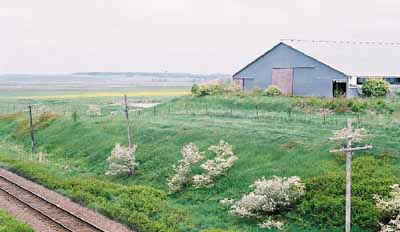Fort Lawrence National Historic Site of Canada
Fort Lawrence, Nova Scotia

General view
© Parks Canada Agency / Agence Parcs Canada, Philip Goldring, 2003.
Address :
Fort Lawrence Road, Fort Lawrence, Nova Scotia
Recognition Statute:
Historic Sites and Monuments Act (R.S.C., 1985, c. H-4)
Designation Date:
1923-05-25
Dates:
-
1750 to 1750
(Construction)
-
1750 to 1756
(Significant)
Event, Person, Organization:
-
Seven Years' War
(Event)
-
Deportation of the Acadians
(Event)
-
Major Charles Lawrence
(Person)
-
Louis de la Corne, Chevalier de la Corne
(Person)
Other Name(s):
-
Fort Lawrence
(Designation Name)
Research Report Number:
2005-SDC-080
DFRP Number:
56566 00
Plaque(s)
Existing plaque: Mounted on monument on Fort Lawrence Rd, 750m south of Trans Canada Hwy Fort Lawrence Rd, 750m south of Trans Canada Hwy, Nova Scotia
In 1672, Jacques Bourgeois and other settlers from Port Royal founded the Acadian village of Beaubassin in this strategic area. In 1750, the French burned the village in the face of the advancing English under Major Charles Lawrence and withdrew across the river where they build Fort Beauséjour. The English built Fort Lawrence on this ridge. Hopes of maintaining the long-disputed border at the Missiguash and saving that part of Acadia for France were dashed when in 1755 Fort Beauséjour was captured. It became the English garrison and Fort Lawrence was abandoned.
Original Plaque: Nova Scotia
Erected in 1750 by Major Charles Lawrence, afterwards Lieut.-
Governor of Nova Scotia, for the defense of the isthmus of Chignecto: garrisoned by British troops until after the capture of Fort Beauséjour, when it was abandoned.
Immediately south of the fort was the village of Beaubassin, one of the oldest french settlements in Nova Scotia, founded by Jacques Bourgeois and others from Port Royal in 1672, evacuated and burned by the French in 1750, prior to the erection of Fort Lawrence.
Description of Historic Place
Fort Lawrence National Historic Site of Canada, located on Fort Lawrence Road in Cumberland County, Nova Scotia, is an archaeological site lying atop a gentle ridge surrounded by pasture fields, on the east side of the Missaguash River. Completely built over by a dairy farm, archaeological resources relating to this 18th-century fort’s former embankments and trenches, which were visible until 1991, may yet survive under the dairy barn and yard. Further archaeological remains survive across the entire property administered by Parks Canada. The official recognition refers to a polygon that includes the former footprint of the fort’s earthworks.
Heritage Value
Fort Lawrence was designated a national historic site of Canada in 1923 because: Fort Lawrence was erected in 1750 by British troops for the defense of the isthmus of Chignecto and abandoned in 1755 after the capture of Fort Beauséjour.
A highly strategic area, the site was occupied for nearly a century before the construction of Fort Lawrence. In 1672, Jacques Bourgeois and other settlers from Port Royal founded the Acadian village of Beaubassin, which grew into a thriving village and one of the largest Acadian settlements. However, in 1750, the French learned of an advancing British army under Major Charles Lawrence and burned the village to the ground. The French, under Louis de la Corne, Chevalier de la Corne, withdrew west across the Missaguash River where they began securing territory. Although Major Lawrence was mandated to secure territory east of the River, his forces were unable to secure the eastern ridge, and French soldiers, along with their Acadian and aboriginal allies drove the British from the area. The British withdrew to Halifax, returning in the fall of 1750 to the east side of the Missaguash River, where they erected Fort Lawrence, which consisted of three large wooden barrack frames and two wooden blockhouses. The French responded by constructing Fort Beauséjour on the opposite ridge the following year. In 1755, a British expedition captured Fort Beauséjour and renamed it Fort Cumberland. It became the British garrison and Fort Lawrence was abandoned.
Sources: Historic Sites and Monuments Board of Canada, Minutes, 1923, October 2005.
Character-Defining Elements
Key elements contributing to the heritage value of this site include: its location in the town of Fort Lawrence, Nova Scotia; its siting in a rural landscape on the east side of the Missaguash River; the integrity and materials of the surviving subsurface archaeological remains, features and artefacts in their original placement and extent, including the in situ vestiges, and various discrete archaeological features both identified and as yet unidentified that lie beneath the floor of the dairy barn and its adjacent yard that date to the period of occupation of Fort Lawrence and the settlement of Beaubassin, most notably the former embankments and trenches; the subsurface deposits relating to fort and settlement which exist beyond the barn; the continued association of the site with archaeological objects removed for research purposes; its continued spatial relationship to Fort Beauséjour – Fort Cumberland National Historic Site of Canada and Beaubassin National Historic Site of Canada.